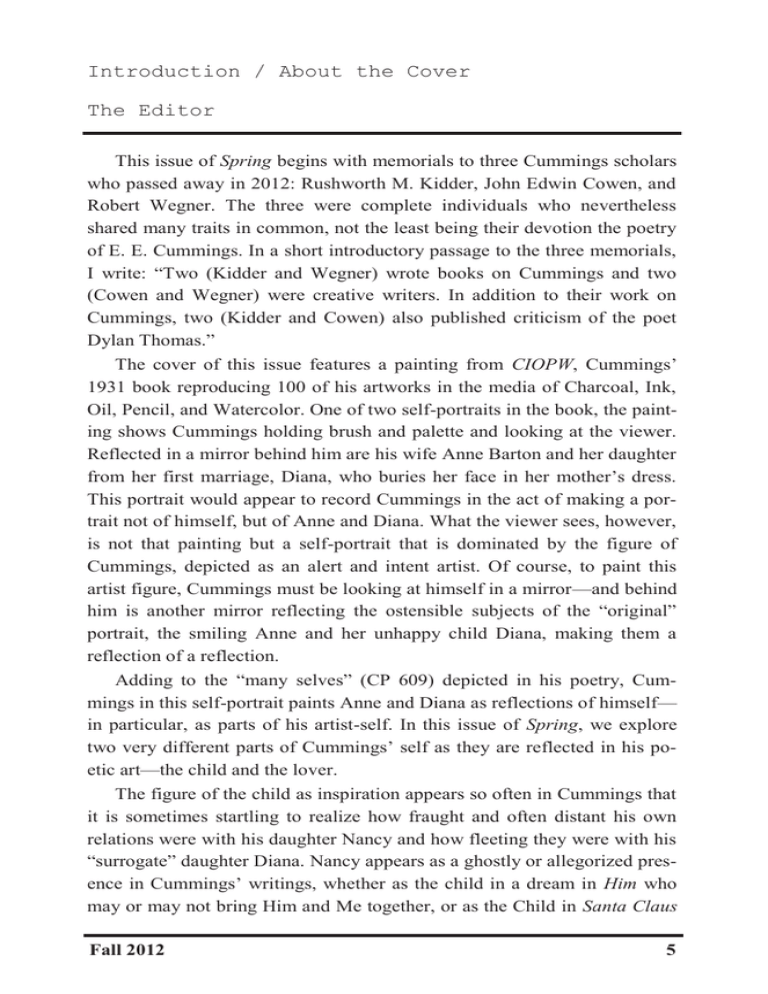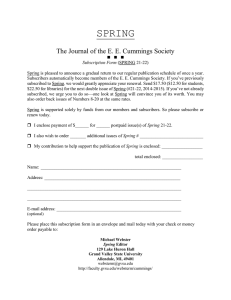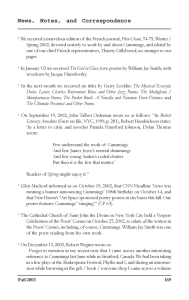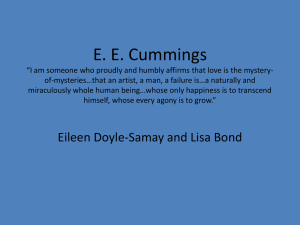Introduction / About the Cover The Editor
advertisement

Introduction / About the Cover The Editor This issue of Spring begins with memorials to three Cummings scholars who passed away in 2012: Rushworth M. Kidder, John Edwin Cowen, and Robert Wegner. The three were complete individuals who nevertheless shared many traits in common, not the least being their devotion the poetry of E. E. Cummings. In a short introductory passage to the three memorials, I write: “Two (Kidder and Wegner) wrote books on Cummings and two (Cowen and Wegner) were creative writers. In addition to their work on Cummings, two (Kidder and Cowen) also published criticism of the poet Dylan Thomas.” The cover of this issue features a painting from CIOPW, Cummings’ 1931 book reproducing 100 of his artworks in the media of Charcoal, Ink, Oil, Pencil, and Watercolor. One of two self-portraits in the book, the painting shows Cummings holding brush and palette and looking at the viewer. Reflected in a mirror behind him are his wife Anne Barton and her daughter from her first marriage, Diana, who buries her face in her mother’s dress. This portrait would appear to record Cummings in the act of making a portrait not of himself, but of Anne and Diana. What the viewer sees, however, is not that painting but a self-portrait that is dominated by the figure of Cummings, depicted as an alert and intent artist. Of course, to paint this artist figure, Cummings must be looking at himself in a mirror—and behind him is another mirror reflecting the ostensible subjects of the “original” portrait, the smiling Anne and her unhappy child Diana, making them a reflection of a reflection. Adding to the “many selves” (CP 609) depicted in his poetry, Cummings in this self-portrait paints Anne and Diana as reflections of himself— in particular, as parts of his artist-self. In this issue of Spring, we explore two very different parts of Cummings’ self as they are reflected in his poetic art—the child and the lover. The figure of the child as inspiration appears so often in Cummings that it is sometimes startling to realize how fraught and often distant his own relations were with his daughter Nancy and how fleeting they were with his “surrogate” daughter Diana. Nancy appears as a ghostly or allegorized presence in Cummings’ writings, whether as the child in a dream in Him who may or may not bring Him and Me together, or as the Child in Santa Claus Fall 2012 5 who reunites the Woman and Santa Claus at the end. Simon PowersSchaub’s paper examines the dream of the child in Him as a wishfulfillment fantasy that may say more about Him’s inability to be (re)born than it does about Him and Me’s foundering relationship. In her paper, M. Teresa González Mínguez sifts through the scattered evidence to find the biographical presence of Diana Barton in Cummings’ life. Although she uncovers few or no traces of Diana in Cummings’ published writings, Teresa does find that Diana appears in CIOPW, not only in the painting on our cover but also in a portrait of her own. Examining some of the references to the child in EIMI, Michael Webster’s article, “Lugete: The Divine Lost and Found Child in Cummings,” shows the child as a divine source of inspiration who becomes lost in the “real” life of adulthood and yet is found again in art. Aaron Moe’s article, “An Ontological Crisis: Rethinking E. E. Cummings’ Fairy Tales,” concludes our section on the child with a plea for readers to take seriously the art of Cummings’ Fairy Tales. Aaron writes: “For Cummings . . . the trope of the child endured throughout his life, and it enabled him to succeed in his battle. He did not dismiss the circus; he did not dismiss fairy tales; he did not dismiss the ontology of the child.” In addition to publishing criticism on the poet Dylan Thomas, John Edwin Cowen published at the end of his life a book called Poems from Dylan’s Wales, celebrating the Welsh poet and his native Swansea. In this issue, we feature six poems from this book. Following John’s poems, we reproduce Jacques Demarcq’s “les calder,” poems crafted in the form of two of Alexander Calder’s mobiles: Untitled (1938—one of the first hanging mobiles) and Snow Flurry (1948). Our (re)consideration of Cummings and the erotic begins with April Fallon’s “Love, Unlove, and Lust: Cummings’ Use of the Surreal in his Love and Erotic Poetry.” April shows us the complexity of Cummings’ views of the erotic, characterizing sex in his poetry “as a powerful regenerative force . . . a primordial force not subject to morality, and a force that, when united with love, is an experience of the sacred and eternal.” Liz Reilly’s “ ‘my sweet old etcetera’: Reading and Critiquing the Erotic in E. E. Cummings’ Poetry” combines readings of previous criticisms of Cummings’ erotica with close readings of individual poems in order to place the erotic poems in the context of early modernism and to show how the erotic fits into the many “moods” of Cummings’ poetry. In “Pursuing a Strategy of Fulfillment: Cummings’ Erotic Language,” 6 Spring 19 Millie Kidd continues the focus on locating Cummings’ erotica by showing how the bodily becomes embodied in the language games of his poetry so that “we are constantly made aware of the material presence of the words themselves, their physicality, their ‘thinginess,’ as well as their semantic meaning.” Gillian Huang-Tiller concludes this section with “A(r)mor amoris: Modernist Blazon, History, and the Body Politic of Cummings’ Erotic Sonnetry in & [AND].” Gillian aims to move the discussion of Cummings’ erotic poems “beyond a general perception of the poet’s ‘bad taste’” in order to consider them as literary works of art, many written within and against the sonnet tradition. A sheaf of poems (some maybe erotic?) follows from poets familiar and new to Spring readers: Wayne Daniel, Greg Moglia, E. M. Schorb, Guy Beining, Gerald Locklin, Michael Vaughn, and Max West. Our review section opens with Robert Dorsett’s appreciation of John Edwin Cowen’s Mathematics of Love (2011). Dorsett shows how Cowen’s poems are indebted both to Cummings and José Garcia Villa and yet are singular expressions of a surprising poet. Next up are two reviews of books that place Cummings in the context of his modernist contemporaries. Taimi Olsen reviews Milton Cohen’s Beleaguered Poets and Leftist Critics: Stevens, Cummings, Frost, and Williams in the 1930s, while Heidi Bean examines Thomas Fahy’s Staging Modern American Life: Popular Culture in the Experimental Theatre of Millay, Cummings, and Dos Passos. The News, Notes, & Correspondence section as usual features topical news of our nonhero, as well as noteworthy items from poets, translators, and scholars. Among the many items that merit mention, I’d like to single out two. Liveright has published a new edition of The Theatre of E. E. Cummings, which contains the plays Him, Anthropos, and Santa Claus, along with the ballet Tom. And Etienne Terblanche has published a major new critical study, E. E. Cummings: Poetry and Ecology (Amsterdam / New York: Rodopi, 2012). Fall 2012 7









